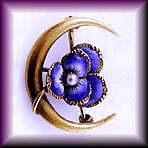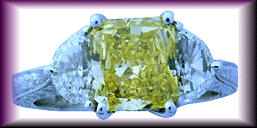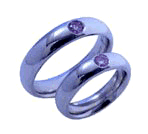
|
|
Issue 2, 2000
|
||
|
Arthur Anderson Editor |
||
|
**********
Victorian Jewels: Puzzles, Secrets and
Hidden Messages The Victorians loved puzzles, riddles and secrets. Even in their jewelry they often hid secret and personal messages. Two of the more intriguing forms of Victorian jewelry are the rebus and the acrostic jewel. In a rebus the elements of a jewel create a phrase or expression. For example, in the collection of the British Museum, there is a wonderful jewel with a honey bee, a knot and an "X" (or cross). These elements suggest the phrase "Honey, be not cross." What a suitable gift from a gentleman who had recently angered his beloved!
Another common rebus jewel features a crescent moon cradling a bee or flower. In this case, the bee or flower represents honey and the jewel is known as a "honey moon brooch." Such brooches are said to have been given by husbands to wives on their wedding night. In an acrostic jewel, gemstone names are used to spell out a word or phrase. For example, consider a ring set with a Diamond, Emerald, Amethyst and Ruby. If you take the first letter of each of these gemstone names, they spell out "D", "E", "A", "R" or "DEAR". Or, a bracelet set with an Emerald, Lapis, Iolite, Sapphire and Amethyst would suggest "Elisa" or "Eliza." Victorian puzzle jewels have always fascinated lovers of antique jewelry. Lately we have also seen a growing interest in acrostic and rebus jewels among our custom design clients. A hidden message is a wonderful way to add special meaning to a custom jewel and create a romantic mystique that will last for generations.
**********
Tickle Your Fancy Color Diamonds - Tickle Your Fancy
by Arthur Anderson In 1817, R.J. Hauy, an eminent French mineralogist, wrote "Gems are the flowers of the mineral kingdom .... fancy colored diamonds are the orchids." Fancy colored diamonds, like orchids, are truly exotic and rare beauties of nature. Yellows, reds, pinks, purples, blues and greens are not what you expect from diamonds. Anyone who has studied the 4 Cs can tell you, "When it comes to diamonds, the less color .... the better." While this is true, it is only true up to a point. Slight traces of color can be annoying and detract from a diamond's beauty and value. But when a diamond sparkles with brilliant, intense color, it is a gem of great rarity and beauty. These extraordinary gems are known as "fancy colored diamonds."
Fancy colored diamonds attain high values because of their great rarity and the attraction they have for gemstone collectors and connoisseurs. It has been estimated that only one out every 10,000 natural diamonds is a fancy color. Among natural colored diamonds the rarest shades are red, pink and green. More common are various shades of yellow and brown.
If a natural red diamond does not fit your budget or your color scheme, you may want to consider one of the more affordable, but equally striking alternatives. Pink diamonds from the Argyle mines in Australia are stunning when set in platinum. Yellow diamonds make striking center stones, especially when set between two smaller colorless diamonds. And purple and blue diamonds will capture you with a unique mystique all their own. While these shades are not as rare as red diamonds, they are just as beautiful and desirable.
Evaluating Fancy Colored Diamonds - the 5 Cs
When evaluating a fancy colored diamond, the 4 Cs are still important, as is the fifth C - cost. However, for colored diamonds some of the rules change.
Color, Color, Color
The most important factor in evaluating a fancy colored diamond is, of course, the richness and beauty of the color. A number of grading systems exist for colored diamonds, but the most prevalent is a 9-tiered scale developed by the Gemological Institute of America (GIA). The GIA grading scale ranges from "Faint" and "Very Light," which strictly speaking are not fancy color grades, to "Fancy Deep" and "Fancy Vivid" where the saturation and intensity of the color just reaches out and grabs you.
When considering a fancy colored diamond, it is important to acquire an origin-of-color report from the GIA or one of the other qualified gemological laboratories. This report will indicate whether the diamond's color is natural or the result of human intervention. The report will also indicate the diamond's color grade. But, do not buy a diamond solely based on a grading report. Even within a color grade, diamonds will be found in a variety of shades and with many subtle variations in hue, tone and saturation. Beauty in a diamond is like beauty anywhere, it is in the eye of the beholder. Always examine and compare fancy colored diamonds firsthand before purchasing one.
Cut
Diamond cutting is a demanding and precise craft requiring a blend of artistry and technical mastery. All diamonds should have a pleasing outline and a beautifully balanced arrangement of facets. But, that is where the similarities between well-cut fancy colored and colorless diamonds end. When cutting a fancy colored diamond, a master diamond cutter strives to enhance the intensity and beauty of the stone's color. Thus, the angles, proportions and arrangement of the facets are set to lengthen the path of the light passing through the stone. The further a light ray travels through a colored diamond, the more it picks up and deepens the stone's color.
In contrast, for colorless or near-colorless diamonds the goal is to maximize the brilliance of the stone and minimize the effect of any trace colors. This is accomplished by shortening the path of light as it is reflected within the stone. What are often called "ideal cuts" for colorless diamonds may not be ideal for a fancy colored stone. While round brilliants are the most common cut for colorless diamonds, among fancy colored diamonds square radiants and ovals are the most prevalent.
Clarity
Like cut, the clarity of a fancy colored diamond is usually less important than the color. Although large and obvious inclusions can detract from a colored diamond's beauty, they are often masked or partially hidden by the intensity of the diamond's color. Compared to colorless stones, clarity is less of a factor in determining the value of a colored diamond.
Carat Weight
Fancy colored diamonds tend to be smaller stones, usually weighing less than a carat. Larger fancy colored diamonds are much rarer than their colorless cousins and, as a result, are significantly more valuable. As the size of fancy colored diamonds increases, their costs increase very rapidly. The good news is that even smaller well-cut stones can display beautiful, intense colors.
Cost
The fifth C is cost. The value of colored diamonds is largely determined by the color and weight of the stone. In the lower color grades of "Light" and "Faint," colored diamonds usually trade for no or only a slight premium over near-colorless stones of comparable weight, cut and clarity. The relatively low premium for these stones reflects the weak, washed out appearance of their color. When set in a jewel, the color in these stones is often masked by the color of the surrounding precious metal. In the middle color grades, "Fancy" through "Fancy Intense," there are many fancy colored diamonds that are beautiful and can be found in affordable sizes. These diamonds are wonderful additions to any gemstone collection and striking center stones when set in a custom designed jewel. As diamonds approach the top color grades, "Fancy Deep" and "Fancy Vivid," their rarity and cost increases sharply. However, these diamonds are truly striking and worth acquiring, if they are within your budget.
Synthetic and Treated Colored Diamonds
The great value of fancy colored diamonds has enticed many modern-day alchemists to try to recreate these rare and beautiful gems in their laboratories. As scientific knowledge of the causes of natural fancy colored diamonds increases, the efforts to create synthetic and treated colored diamonds become more successful. Synthetic diamonds are artificial diamonds that have been created in a laboratory. By varying the heat and pressure during formation, adding foreign elements, and irradiating the finished crystals, synthetic diamonds can be made to imitate natural colored stones. There is currently a wide spectrum of synthetic colored diamonds available. Treated diamonds are natural diamonds that started out with an unappealing or slightly off color. By exposing these less desirable stones to the same high-tech alchemy used to create synthetic colored diamonds, the color and appearance of these diamonds can be materially improved. Recently we have seen treated diamonds with vibrant yellowish green, red and blue colors enter the market. Natural fancy colored diamonds are significantly more valuable and rarer than comparable treated or synthetic stones. Although treated and synthetic diamonds can be beautiful in their own right, the origin of their color should be fully disclosed. They should also cost significantly less than natural diamonds. Ethical practice and the law require that synthetic gemstones and treatments be fully disclosed to consumers. Unfortunately, this does not always happen. As always, be careful!
A Word of Advice
Fancy-colored diamonds are among the rarest and most beautiful gemstones. They are, like orchids, true treasures of nature! Acquiring a colored diamond requires a special expertise. In light of the recent advancements in creating treated and synthetic diamonds and the sometimes deceptive practices of sellers, you may want to seek guidance from an impartial expert. An independent gemologist/appraiser, with a knowledge of fancy colored diamonds and the diamond markets, can help you acquire a stunning diamond of high value at a fair price. As always, education and expertise are your best protection against the games and shenanigans in the diamond market place.
*** We recently added several custom designed jewels featuring fancy colored diamonds to the Bijoux Galleries. One is a pair of platinum bands set with natural pink diamonds, the other is a striking engraved platinum ring with a natural Fancy Intense yellow diamond. These jewels are dazzling, so you may want to put on your sun glasses before viewing! If you wish to acquire a fancy colored or other important diamond, you can hire us to act as your diamond broker. To learn more about how we will serve as your diamond expert, please visit our diamond brokering page.
**********
Jewelry Facts: History of Engagement Rings
The tradition of giving an engagement ring began in the early 1300s when Pope Innocent III declared that there should be a waiting period between becoming engaged and married. Prior to this only a wedding band had been given at the time of marriage. In 1477, the Archduke Maximilian of Austria gave his future bride, Mary of Burgundy, a diamond ring to celebrate their betrothal. Thus began the long tradition of diamond engagement rings. No doubt Innocent III and Archduke Maximilian were very popular with the jewelers and diamond merchants of their day! In keeping with that tradition, we have added several new designs to our engagement rings gallery.
********** Gem Facts: Diamonds - Splinters from the Stars
Diamonds are magical gemstones that are often claimed to possess amazing powers and extraordinary virtues. In fact, the word "diamond" is derived from the ancient Greek word "adamas" meaning strong and unconquerable. In the first century, Pliny the Elder wrote of the amazing powers of diamonds in his opus, Historia naturalis. He suggested a rather alarming technique for testing diamonds: "these stones can be tested on an anvil, and will resist a blow to such an extent as to make the hammer rebound and the very anvil split asunder." Needless to say, we do not use this method in the Bijoux laboratory. Pliny also noted that diamonds "can overcome and neutralize poisons, dispel deliriums, and banish the groundless perturbations of the mind." Of course, if you shatter your diamond on an anvil, you no doubt will feel an increase in angst or "perturbation of the mind." Pliny's legacy continued through the Middle Ages. In the eleventh century, Marbodus, Bishop of Rennes, described diamonds as "providing the wearer with indomitable virtues, repelling nocturnal spirits and bad dreams, causing black poisons to flee, and resolving disputes." He also suggested that diamonds can "cure insanity and strike hard against one's enemies." Part of the allure of diamonds and gemstones are the ancient beliefs and myths that surround them. But of all the myths about diamonds, the most romantic comes from the ancient Greeks. They believed that diamonds were splinters from fallen stars!
********** The editorial staff would like to thank Dorothy S. Anderson for her kind assistance in polishing the many facets of this edition of The Bijoux News.
********** Thank you for reading The Bijoux News. If you have any suggestions, questions, please send Art Anderson, the editor, an e-mail. Please feel free to share this newsletter with your friends or to make copies for your personal use. However, no part of this newsletter is to be used for commercial or other purposes without the express written consent of Bijoux Extraordinaire, Ltd.
Other issues of The Bijoux News can be found the Bijoux News Archive.
|
|
|
||
|
| Reading Room | Jewelry Galleries | What's New! | | Bijoux Home Page | About Us | Services We Offer | Site Map | If you have any questions, suggestions or comments, please give us a call (603 624-8672) or send us an email.
|
||
|
"The Jewelry Experts" and "The Jewelry Expert" are Trade Marks of Bijoux Extraordinaire, Ltd. © Copyright Bijoux Extraordinaire, Ltd.
|
||






